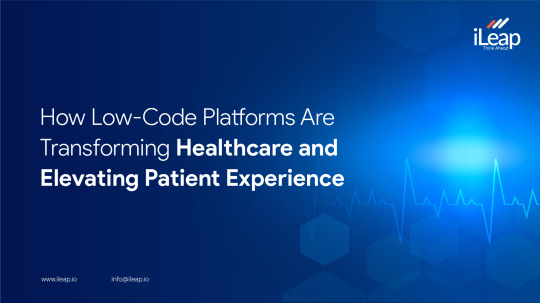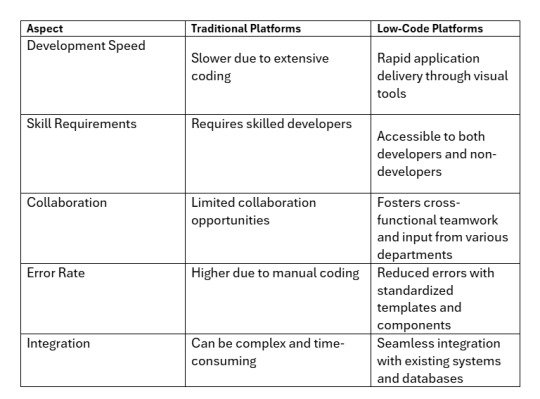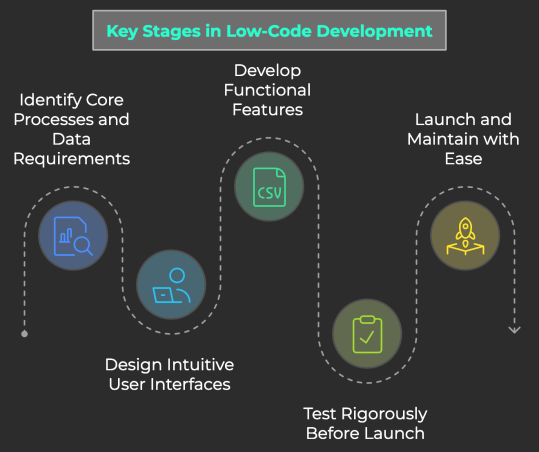#Low Code
Explore tagged Tumblr posts
Text
How Low-Code Platforms Are Transforming Healthcare and Elevating Patient Experience

The healthcare sector is a highly evolving landscape. The current race for digitization has made it crucial for service providers to stay updated with the latest technology and regulations. Patient satisfaction is of the highest requirement, but inefficient processes, paperwork, and security concerns often hinder positive outcomes. To enhance speed, transparency, and efficiency, many providers are turning to low-code platforms, driving digital transformation.
Why Low-Code is a Perfect Fit for Healthcare
Low-code platforms enable both technical and non-technical users to build digital healthcare solutions. It simplifies healthcare operations, speeds-up processes and makes healthcare more accessible for patients.
Most healthcare professionals lack IT training, limiting their ability to use digital tools. Low-code bridges this gap by providing an intuitive interface for rapid, cost-effective app development. With scalable architectures and seamless third-party integration, these platforms improve workflows, patient care, and operational efficiency.
Key Benefits of Low-Code in Healthcare
Workflow Optimization and Automation:
Low-code platforms like iLeap streamline administrative and clinical processes. Automating billing, budgeting, and resource management reduces manual effort and errors. Tasks like appointment scheduling and reminders can also be automated, freeing up time for patient care.
Seamless Integration:
A majority of legacy healthcare enterprises rely on legacy systems which is often a major reason for downtimes and slow processes. A robust low-code platform integrates easily with existing software and third-party applications, ensuring unified workflows without IT disruptions.
Customizable Features:
Low-code solutions automate emails, manage patient records, and schedule appointments efficiently. Platforms like iLeap also support threshold management and escalation for timely responses to critical situations.
Enhancing Patient Care with Low-Code
Patient Registration and Records :
Custom applications streamline patient intake, scheduling, second opinions, and billing, reducing wait times and improving experiences.
Automated Appointment Reminders and Feedback:
By automating reminders and surveys, healthcare staff can focus on critical tasks, reducing no-shows and improving service quality.
Telehealth and Centralized Communication:
Legacy systems cause fragmented communication and delays. Low-code platforms facilitate telehealth solutions, including video consultations, secure messaging, and EHR integration, ensuring timely care.
Compliance and Accountability:
Regulatory compliance is crucial. Low-code solutions streamline reporting and documentation, ensuring transparency and adherence to guidelines. By 2030, on-demand compliance reports will be necessary, making digital transformation essential.
iLeap: Driving Digital Healthcare Transformation
iLeap enables healthcare providers to build secure, scalable applications tailored to their needs. By optimizing workflows, financial management, and patient experiences, iLeap helps organizations stay ahead in digital transformation.
Learn more about iLeap’s low-code application development platform. Schedule a call with us
2 notes
·
View notes
Text
Imagine a future where every business operates at its peak, empowered by software crafted just for them. This isn't a distant dream – it's happening right now! Custom software development is not just optimizing operations; it's redefining the very essence of how businesses function. It's a journey towards excellence, where technology meets creativity to unlock unprecedented potential. Join the conversation on how custom software sets new standards in the business world.
#custom development#softwaredevelopment#business#software solutions#agiledevelopment#low code#tech#future#mobiosolutions#uk
2 notes
·
View notes
Text
It's not just Gen Z and Gen Alpha who I'm worried about as a Software Engineer though. They're trying to take away our tools to build anything and replace them with drag-and-drop GUIs, and I've already been tasked with trying to make the BS they're calling "Anyone Can Make An App" work. Microsoft's entire Power Platform is built on this. They want to avoid individuality or actual features (not bugs!). They want to "eliminate bugs" by forcing you to work in a tiny, infinitesimal space of what you're allowed to do in these new "app builders" instead of having a free range of the app from code to end product. And they claim it's "easier." One example of this was me being the younger programmer (with almost 2 decades under my belt) who was forced to spend four months working in and trying to create something as simple as a Time Off Request App (which is one of their app bases!) in Power Apps to have proof of concept, except all I did was prove that it was a steamy pile of nothing that couldn't work for my high yield company. And it's not just Microsoft that is doing this. iOS and Android have banged out similar "low code" and "no code" options. And don't get me started on using LLMs to do your coding. People are doing it! And releasing apps with it! And they're a freaking nightmare to look at as an engineer who was brought up working in C, C++, Java (plain Java, all these JS Frameworks are gonna collapse and be useless as soon as we figure out what the next big thing is), Python, and even Assembly. I was the last class of Computer Engineering students that was taught Assembly. The lowest-level language they teach at my university now is Java, and it's not even a useful class. It's the kiddie pool like it's always been. I didn't understand anything I was doing until I dropped out after my Junior year, took a community college course, and actually made something from code to finish. it worked, and I could use it. Then, I understood it. This new stuff? They do not want you to know how it works and that is terrifying.
another thought about "gen z and gen alpha don't know how to use computers, just phone apps" is that this is intentionally the direction tech companies have pushed things in, they don't want users to understand anything about the underlying system, they want you to just buy a subscription to a thing and if it doesn't do what you need it to, you just upgrade to the more expensive one. users who look at configuration files are their worst nightmare
#rant#low code#no code#go to hell#app building is currently a cesspool#because so many of them are trying to shove it into little tiny boxes#for no other reason than control#and capitalism#out of credits
79K notes
·
View notes
Text
Low-Code and No-Code Development: Revolutionizing the Future of Software Engineering
Introduction: What is Low-Code and No-Code Development? The digital revolution has birthed a wave of innovation that challenges the traditional notions of software development. At the heart of this transformation lie Low-Code and No-Code Development Platforms (LCDPs/NCDPs), which empower users with little to no programming knowledge to build sophisticated applications using intuitive,…
0 notes
Text
Discover the future of website development with low code and no code platforms. Learn how Site It Now’s Website Development Services can help.
#Site It Now#No Code#No Code Platforms#Low Code#Low Code Platforms#Website Builders#Website Development Company#eCommerce Website Development#Custom Web Development
0 notes
Text

AI Auto Code Application Development: The Future of Software Engineering
Introduction
In today's rapidly evolving digital landscape, AI-powered auto code application development is transforming how businesses and developers approach software creation. With advancements in machine learning (ML) and natural language processing (NLP), AI is now capable of generating, optimizing, and debugging code with minimal human intervention. This revolution is paving the way for faster, more efficient, and cost-effective software development.
What is AI Auto Code Application Development?
AI auto code application development refers to the process where artificial intelligence assists in the generation, optimization, and maintenance of software code. These AI-driven systems analyze large datasets, learn programming patterns, and write code snippets or entire programs automatically.
Key Features of AI-Driven Coding Tools
Automated Code Generation – AI models like OpenAI's Codex and Google's AlphaCode can generate code based on human instructions.
Bug Detection & Fixing – AI-powered tools analyze the codebase to detect and resolve bugs more efficiently than manual debugging.
Code Optimization – AI can optimize algorithms for better performance and reduced complexity.
Predictive Analytics – AI suggests improvements based on previous coding patterns and best practices.
Natural Language Processing – AI interprets human language commands and converts them into working code.
Benefits of AI in Software Development
1. Increased Productivity
AI automates repetitive tasks, reducing the workload for developers. This allows software engineers to focus on higher-level problem-solving and innovation.
2. Enhanced Code Quality
AI-powered tools help developers produce cleaner, error-free code by adhering to industry best practices and automatically refactoring inefficient segments.
3. Faster Time-to-Market
Automating coding and debugging processes accelerates the software development lifecycle, enabling businesses to launch products faster.
4. Cost Efficiency
By minimizing manual coding efforts and reducing errors, AI-powered development significantly lowers software production costs.
5. Better Collaboration
AI-driven platforms enable seamless collaboration between developers, ensuring consistent coding standards across teams.
Top AI-Powered Coding Tools in 2024
1. GitHub Copilot
GitHub Copilot, powered by OpenAI's Codex, assists developers by suggesting code snippets in real-time, improving efficiency and accuracy.
2. Tabnine
Tabnine enhances autocomplete functionality by learning from millions of code repositories, offering smart recommendations for multiple programming languages.
3. Kite
Kite provides AI-powered code completions and documentation, helping developers write better code faster.
4. DeepCode
DeepCode utilizes AI to detect security vulnerabilities and suggest code improvements, enhancing software reliability.
5. Codiga
Codiga analyzes code quality in real time, offering instant feedback and best practice recommendations.
How AI is Changing the Role of Developers
1. Shift Towards AI-Augmented Development
Instead of replacing developers, AI acts as an augmentation tool, allowing engineers to automate mundane tasks and focus on complex logic and architecture.
2. Democratization of Coding
AI-powered tools make programming more accessible to non-coders, enabling business analysts and domain experts to contribute to software development.
3. Increased Focus on AI Ethics and Security
With AI writing code, developers must prioritize ethical AI use and cybersecurity to prevent biases, vulnerabilities, and unauthorized data access.
Challenges in AI Auto Code Development
1. Code Accuracy and Reliability
While AI-generated code is highly efficient, it may still produce errors or require human intervention for verification.
2. Intellectual Property Concerns
As AI learns from open-source repositories, ensuring compliance with licensing agreements and intellectual property laws is critical.
3. Security Risks
AI-written code can introduce vulnerabilities if not properly reviewed, emphasizing the need for stringent security checks.
4. Dependence on Training Data
AI models rely on extensive datasets, and biases in training data can result in suboptimal code suggestions.
Future of AI in Software Development
1. Fully Autonomous Software Engineering
In the near future, AI will not only assist in coding but also manage entire software projects from planning to deployment.
2. Integration with No-Code and Low-Code Platforms
AI will enhance no-code/low-code platforms, allowing businesses to build applications without extensive programming knowledge.
3. AI-Driven Software Maintenance
AI will proactively monitor and maintain software applications, reducing downtime and improving efficiency.
4. AI-Powered Collaboration
AI will facilitate smoother collaboration between developers, designers, and stakeholders by bridging the communication gap through intelligent automation.
Conclusion
AI-driven auto code application development is revolutionizing the software industry by improving efficiency, reducing costs, and accelerating time-to-market. While challenges remain, the potential of AI in coding is undeniable. By integrating AI-powered tools into their workflows, businesses and developers can stay ahead in the competitive world of technology.
0 notes
Text






Some very well attended Mendix meetup and business conference events
0 notes
Text
How Data Analytics is Driving Decision-Making in BPOs: The Argos Labs Advantage

How Data Analytics is Driving Decision-Making in BPOs: The Argos Labs Advantage
The Business Process Outsourcing (BPO) industry is experiencing a dramatic transformation, fueled by the exponential growth and accessibility of data analytics. No longer solely reliant on intuition and historical trends, forward-thinking BPOs are leveraging the powerful insights derived from data to make faster, smarter, and more efficient decisions across all facets of their operations. This data-driven approach is fundamentally reshaping how BPOs optimize processes, enhance customer experiences, elevate operational efficiency, and ultimately deliver exceptional value to their clients. The shift towards data-centric decision-making is not just a trend; it's a strategic imperative for survival and growth in the increasingly competitive BPO landscape.
Boosting Efficiency and Reducing Operational Costs:
One of the most immediate and tangible benefits of data analytics in BPOs is the precise identification and subsequent elimination of operational bottlenecks. By meticulously analyzing data related to process times, resource allocation, error rates, and employee performance, BPOs gain a granular understanding of their operational strengths and weaknesses. This detailed insight allows for targeted improvements, streamlining workflows and resulting in substantial gains in productivity. For example, analyzing call center data reveals peak call times, average handling times, and customer wait times, informing staffing decisions, optimizing call routing strategies, and ultimately enhancing customer satisfaction. Similarly, analyzing data from document processing workflows identifies bottlenecks that can be addressed to accelerate turnaround times and improve accuracy.
Argos Labs' suite of data integration and automation tools plays a crucial role in accelerating this process. By automating data collection and analysis from disparate sources, Argos Labs provides a single, unified source of truth for operational insights. This consolidated view eliminates data silos and ensures consistency, allowing for quicker identification of bottlenecks and the timely implementation of effective solutions. The platform's automated reporting features further enhance the ability to monitor performance and make informed, data-driven adjustments. This heightened efficiency directly translates into significant cost savings, as resources are utilized more effectively and operational expenses are reduced. Data-driven insights also reveal opportunities to optimize resource allocation, ensuring personnel and technology are deployed strategically where they are most needed.
Personalizing Customer Experiences and Fostering Loyalty:
Data analytics is revolutionizing customer experience within the BPO sector. By analyzing customer interactions, feedback surveys, transactional data, and social media sentiment, BPOs gain a comprehensive understanding of individual customer preferences, needs, and pain points. This granular understanding enables the creation of highly personalized solutions tailored to meet specific requirements, enhancing customer satisfaction and fostering loyalty. For instance, analyzing customer service interactions identifies recurring issues, informing improvements to training programs, processes, and knowledge bases. Analyzing customer purchasing behavior allows BPOs to create targeted marketing campaigns and personalized offers, increasing customer engagement and lifetime value.
Argos Labs' tools enable seamless integration of customer data from various sources, creating a unified, 360-degree view of the customer journey. This holistic understanding facilitates the development of targeted marketing campaigns, personalized service strategies, and proactive customer support interventions. By anticipating customer needs and proactively addressing potential issues, BPOs can transform customer interactions into meaningful and positive experiences, strengthening customer relationships and driving loyalty. This personalization not only increases customer satisfaction but also contributes to increased revenue and reduced customer churn.
Real-Time Informed Decision-Making: A Proactive Approach:
Real-time data analytics is empowering BPO managers to make rapid, informed decisions, moving away from reactive responses to proactive strategies. Access to up-to-the-minute data on key performance indicators (KPIs) allows for immediate adjustments to strategies and operations. This real-time feedback loop enables BPOs to respond swiftly to changing market conditions, customer demands, and emerging challenges. For example, monitoring customer satisfaction scores in real-time allows for immediate corrective action if scores begin to decline, preventing potential reputational damage.
Argos Labs provides the essential infrastructure for real-time data ingestion and processing, delivering actionable insights instantaneously. This capability empowers BPOs to anticipate and address potential issues before they escalate, improving overall operational agility and responsiveness. Automated dashboards and reporting features further enhance the ability to monitor performance and make timely adjustments, ensuring that operations remain aligned with strategic objectives. This proactive approach minimizes the risk of significant problems escalating and safeguards the reputation of both the BPO and its clients.
Optimizing Talent Management and Enhancing Employee Performance:
Data analytics is transforming talent management within BPOs, moving beyond traditional performance reviews to a data-driven approach. By analyzing employee performance data, including productivity, accuracy, error rates, attrition rates, and training effectiveness, BPOs can identify trends and predict future workforce needs. This predictive capability allows for more effective recruitment strategies, targeted training programs, and data-informed performance management initiatives. For example, identifying employees at risk of burnout or attrition allows for proactive interventions, improving employee retention and reducing associated costs.
Argos Labs' solutions facilitate the efficient collection and analysis of employee performance data, enabling BPOs to identify patterns and make data-driven decisions related to recruitment, training, and retention. This data-driven approach not only optimizes individual and team performance but also fosters a more engaged and productive workforce. The ability to predict potential attrition allows for targeted interventions, reducing turnover costs and preserving institutional knowledge.
Predictive Analytics: Anticipating Future Trends and Mitigating Risks:
Predictive analytics takes the capabilities of data analytics a step further, empowering BPOs to anticipate future trends and proactively address potential challenges. By applying advanced statistical modeling and machine learning techniques to historical data, BPOs can forecast demand, anticipate customer preferences, and even identify potential risks. This forward-looking approach allows BPOs to remain competitive and adapt to evolving market demands. For example, predicting fluctuations in call volume allows BPOs to adjust staffing levels accordingly, preventing service disruptions during peak periods. Similarly, predictive analytics can identify potential risks, such as fraud or security breaches, enabling proactive mitigation strategies.
Argos Labs' advanced analytics capabilities empower BPOs to leverage machine learning and statistical modeling, enabling them to unlock the full potential of their data. This allows for more accurate forecasting, improved resource allocation, and proactive risk management. By anticipating future trends and proactively addressing potential challenges, BPOs can maintain a competitive advantage and ensure sustained growth.
The Argos Labs Advantage: A Comprehensive Solution for Data-Driven BPOs:
Argos Labs offers a comprehensive suite of tools that streamline the entire data analytics process within BPOs. From data integration and automation to advanced analytics and reporting, Argos Labs empowers BPOs to leverage the full potential of their data, transforming their operations and enhancing their competitiveness. Specifically, Argos Labs helps BPOs by:
Automating data collection and processing: Reducing manual effort and ensuring data accuracy.
Providing real-time dashboards and reporting: Enabling proactive decision-making.
Facilitating seamless data integration: Creating a unified view of customer and operational data.
Powering advanced analytics and predictive modeling: Uncovering valuable insights and forecasting future trends.
Enhancing operational efficiency and reducing costs: Optimizing resource allocation and streamlining workflows.
By partnering with Argos Labs, BPOs can unlock the true potential of data analytics, driving significant improvements in efficiency, customer satisfaction, and overall business performance. The future of the BPO industry is undeniably data-driven, and Argos Labs provides the tools and expertise to help BPOs not only survive but thrive in this dynamic and rapidly evolving landscape.
0 notes
Text
The Need for Digitization in Manufacturing : Stay Competitive With Low-Code

Industry 4.0 is transforming manufacturing with smart factories, automation, and digital integration. Technologies like the Internet of Things (IoT), artificial intelligence (AI), and low-code applications are enabling manufacturers to streamline processes and develop customized solutions quickly. Low-code platforms empower manufacturers to adapt to global demands, driving efficiency and innovation.
Previously, cross-border transactions in manufacturing faced delays due to bureaucracy, complex payment mechanisms, and inconsistent regulations. These challenges led to inefficiency and increased costs. However, Industry 4.0 technologies, such as digital payments, smart contracts, and logistics tracking, have simplified international transactions, improving procurement processes.
Low-code applications are key in this transformation, enabling rapid development of secure solutions for payments, customs clearance, and regulatory compliance. These platforms reduce complexity, enhance transparency, and ensure cost-effective, secure global supply chains. This shift aligns with the demands of a connected global economy, enhancing productivity and competitiveness.
The Need for Digitization in Manufacturing
Digitization has become crucial for manufacturing to stay competitive, with new technologies and the need for automation driving the sector’s transformation. Key features include ERP systems for centralized management of inventory, finances, and operations; digital supply chain tools for visibility and disruption prediction; real-time data for performance monitoring; sustainability tracking; and IoT/RFID for better tracking, accuracy, and reduced waste.
Low-code applications play a pivotal role in digitization by enabling rapid development of tailored solutions for inventory management, supply chain optimization, and performance analytics. These platforms streamline processes, reduce manual work, and enhance agility, helping manufacturers implement digital transformations quickly and cost-effectively.
Upgrading Manufacturing Capabilities in the Era of Industry 4.0 with Low-code Solutions
Low-code applications are becoming essential for digital transformation in manufacturing, addressing operational challenges while managing increased production demands and a shortage of skilled staff. These platforms enable manufacturers to quickly develop tailored applications without needing specialized coding expertise, fostering faster, more flexible operations. By streamlining processes and aligning with modern consumer demands, low-code technology helps bridge the skills gap, empowering manufacturers to stay competitive and seize new opportunities in a rapidly evolving market.
Low-code Technology Benefits for Modern Industries
As digital transformation becomes increasingly crucial for manufacturing, many enterprises in the sector face challenges with outdated processes, legacy system limitations, customization challenges, and inadequate resources. Low-code applications offer a compelling solution, enabling manufacturers to streamline operations by eliminating paper-based processes and automating workflows across functions such as Production, Sales, Logistics, Finance, Procurement, Quality Assurance, Human Resources, Supply Chain, and IT Operations. Additionally, low-code platforms enhance compliance and safety standards through built-in automated tools.
These platforms deliver impressive results, including over 70% improvement in productivity and close to 95% improvement in output quality in specific scenarios. This is particularly evident in automating complex processes like order fulfillment—from receiving customer orders to delivering finished products and managing invoicing with customers. Use cases also include automating inventory management, enhancing predictive maintenance with real-time data, and optimizing supply chain operations. Low-code solutions make it easier for manufacturers to implement changes quickly, boosting agility and reducing time-to-market while improving overall operational efficiency.
Conclusion
Low-code platforms are driving digital transformation in manufacturing, addressing sector-specific challenges in industries like automotive, aviation, and oil & gas. With Industry 4.0 and smart manufacturing, iLeap’s low-code platform helps integrate IoT, advanced analytics, and end-to-end automation, leading to optimized workflows and real-time decision-making. By adopting agile development, manufacturers can quickly adapt to new technologies and market demands, making iLeap the ideal partner for digital transformation. Unlock the potential of Industry 4.0 with iLeap and turn challenges into growth opportunities.
3 notes
·
View notes
Text
What Is Web Scraping and Why Does It Matter?
Ever spent hours copying and pasting data for market research or competitor analysis? Enter web scraping—your shortcut to extracting online info automatically. Imagine tracking product prices, building prospect lists, or monitoring competitor updates, all without the repetitive manual work.
Here’s the rundown:
Effortless Automation: Pull “hidden” data straight from source code—no coding background required!
Save Time & Energy: Let Headless Browser + ChatGPT handle the routine tasks (you can chill while it scrapes).
Organized Results: Transform messy pages into clean spreadsheets or JSON files for easy analysis.
Stay Ethical & Secure: Use best practices and site rules—no overloading servers or breaking TOS.
Who’s this for?
Entrepreneurs needing up-to-date market info
Marketers and analysts staying ahead of the competition
Anyone who values turning chaos into usable data
Ready to dive in? Web scraping is the power move to convert the vast internet into the neat dataset you’ve always wanted.
#WebScraping #Automation #DataAnalysis #TechTips #ProductivityHacks
0 notes
Text
The web development world is buzzing with innovation, and as we step into 2025, one trend stands out loud and clear: the unstoppable rise of no-code and low-code tools. Whether you’re a seasoned developer, a business owner, or someone with zero technical knowledge, these platforms are changing the game. Let’s dive into what this means and why you should care.
0 notes
Text
Tired of waiting for developers? Build your apps in a flash with the Mendix Rapid Developer Course!
Waiting for developers to build and deploy applications in today's fast-paced digital world can slow your business growth. What if you could take control and create your applications without needing extensive coding knowledge? The Mendix Rapid Developer Course is your solution to building apps quickly, efficiently, and confidently!

What is Mendix? Mendix is the market leader in low-code platforms that empower individuals and teams to rapidly build applications. Using an intuitive interface and drag-and-drop functionality, Mendix removes the pain of traditional coding. As a business professional, project manager, or aspiring developer, Mendix makes app development accessible to everyone.
Why the Mendix Rapid Developer Course?
It is designed for those who need to speed up the pace of their entry into app development. Some of its key benefits include no prior coding experience, hands-on, building real-world applications, and certification on achieving the Mendix Rapid Developer Certification. One can save ample time by creating a fully functional app in days where it otherwise might take weeks or months. Career Advancement: Stand out in the market with expertise on the sought-after low-code platform, Mendix.
What You Will Learn?
This course introduces you to Mendix. Here, through skills acquired and enhanced, one can: Navigate on Mendix Studio and Mendix Studio Pro Environments Design and deploy from simple to moderate application complexity Integrate APIs and manage data models. Understand how workflows, as well as the logic related to apps functions
Who Needs to Take It?
This Rapid Developer Course using Mendix would suit anyone : Business professionals who would like to build apps for their internal processes
Entrepreneurs who want to prototype and go live with an idea IT teams looking to reduce their development backlog Anybody interested in dipping their toes into the world of low-code development
Start Your Low-Code Journey Today
With Mendix, app development is no longer a programmer's exclusive domain. The Mendix Rapid Developer Course enables you to bring your ideas to life without waiting for developers. Just imagine the time, money, and effort you can save building your applications in-house.
No more technical barriers.
Sign up today for the Mendix Rapid Developer Course, which will help transform your app development process.
Take a first step into the future where apps are built like flashes and leverage the innovation potential of your organization.
Visit our website to learn more about the Mendix Rapid Developer Course and get started on your low-code journey. Build your apps and be the change your business needs!
Related Courses:
Mendix Courses
Mendix Intermediate Developer Course
Mendix Advanced Developer Course
0 notes
Text

Creatio, PEGA, dan OutSystems dalam Sudut Pandang Efisiensi Waktu dan Kompleksitas dalam Pengembangan Aplikasi
Di era digital yang berkembang pesat, kecepatan dalam mengembangkan aplikasi berbasis web atau mobile menjadi sangat penting bagi perusahaan untuk tetap bersaing. Dengan hadirnya platform low-code, pengembang kini dapat membangun aplikasi lebih cepat dengan sedikit pengkodean, mengurangi kompleksitas pengembangan, serta mengurangi beban pekerjaan yang biasanya memakan waktu berbulan-bulan. Tiga platform low-code yang populer, yaitu Creatio, PEGA, dan OutSystems, menawarkan solusi bagi pengembang dan perusahaan untuk mempercepat waktu pengembangan. Namun, masing-masing platform memiliki kelebihan dan tantangan tersendiri dalam hal efisiensi waktu dan kompleksitas. Artikel ini akan membahas perbandingan ketiga platform tersebut dalam konteks pengembangan aplikasi.
1. Creatio: Solusi Low-Code untuk CRM dan Proses Bisnis
Creatio, yang sebelumnya dikenal dengan nama bpm'online, adalah platform low-code yang berfokus pada manajemen proses bisnis (BPM) dan customer relationship management (CRM). Dengan antarmuka grafis dan komponen siap pakai, Creatio memungkinkan pengembang untuk membuat aplikasi dengan cepat tanpa menulis banyak kode.
Efisiensi Waktu: Creatio sangat efisien dalam mengembangkan aplikasi yang berfokus pada manajemen hubungan pelanggan dan proses bisnis standar. Platform ini menyediakan templat dan alur kerja siap pakai yang mempercepat pengembangan aplikasi dalam domain CRM. Pengembang dapat dengan mudah menyusun aplikasi tanpa perlu menulis kode dari awal.
Kompleksitas: Namun, Creatio lebih terbatas dalam hal fleksibilitas dan kustomisasi. Meskipun efisien dalam konteks aplikasi CRM dan alur kerja yang sudah terstruktur, platform ini tidak terlalu cocok untuk aplikasi dengan kebutuhan proses bisnis yang sangat kompleks. Bagi perusahaan yang membutuhkan aplikasi dengan alur kerja yang sangat disesuaikan, Creatio bisa terasa agak terbatas.
2. PEGA: Solusi untuk Automasi Alur Kerja dan Pengelolaan Keputusan
PEGA adalah salah satu platform low-code yang paling kuat dalam hal automasi proses bisnis dan pengelolaan keputusan. Platform ini banyak digunakan di sektor keuangan, asuransi, dan telekomunikasi, di mana pengelolaan alur kerja dan keputusan yang dinamis sangat penting.
Efisiensi Waktu: PEGA memungkinkan pengembang untuk membangun aplikasi dengan cepat, terutama ketika aplikasi tersebut membutuhkan pengelolaan alur kerja dan keputusan otomatis. Platform ini menawarkan fungsionalitas low-code yang mempercepat pengembangan, serta kemampuan untuk mengotomatisasi proses bisnis yang kompleks. Bagi aplikasi yang memerlukan pengambilan keputusan berbasis data secara real-time, PEGA adalah pilihan yang sangat efisien.
Kompleksitas: Namun, penggunaan PEGA untuk aplikasi yang lebih sederhana bisa menjadi terlalu rumit dan berlebihan. PEGA menawarkan banyak fitur canggih yang dapat menangani proses bisnis yang sangat kompleks, tetapi bagi pengembang yang baru mengenal platform ini, ada kurva pembelajaran yang lebih curam dibandingkan dengan platform lain seperti Creatio atau OutSystems. Selain itu, tingkat kustomisasi yang ditawarkan bisa sangat tinggi, namun membutuhkan keahlian teknis yang lebih mendalam.
3. OutSystems: Kecepatan dan Fleksibilitas untuk Aplikasi Web dan Mobile
OutSystems adalah platform low-code yang memungkinkan pengembangan aplikasi mobile dan web dengan cepat, dengan integrasi backend yang kuat dan fitur siap pakai yang memudahkan pengembang dalam membangun aplikasi fungsional.
Efisiensi Waktu: OutSystems menawarkan kecepatan pengembangan yang luar biasa. Platform ini memiliki banyak komponen dan modul siap pakai, serta antarmuka grafis yang memudahkan pengembang untuk membuat aplikasi tanpa perlu menulis banyak kode. Dengan menggunakan OutSystems, pengembangan aplikasi yang biasanya memakan waktu berbulan-bulan dapat diselesaikan dalam waktu yang jauh lebih singkat. Selain itu, integrasi dengan sistem backend dan aplikasi yang ada juga menjadi lebih mudah, mempercepat waktu pengembangan aplikasi yang membutuhkan konektivitas lintas sistem.
Kompleksitas: OutSystems menawarkan keseimbangan antara kemudahan penggunaan dan fleksibilitas. Meskipun pengembangan aplikasi dengan platform ini relatif lebih mudah dibandingkan dengan PEGA, ia tetap menyediakan opsi kustomisasi yang luas, memungkinkan pengembang menulis kode kustom untuk menyesuaikan aplikasi dengan lebih baik. Namun, ketika aplikasi membutuhkan kustomisasi tingkat lanjut, pengembang perlu memiliki pemahaman yang lebih mendalam tentang kode dan struktur aplikasi. Meskipun tidak sekompleks PEGA, OutSystems tetap membutuhkan keterampilan teknis yang cukup bagi pengembang yang ingin memanfaatkan fitur-fitur canggihnya.
Perbandingan: Efisiensi Waktu vs. Kompleksitas
PlatformEfisiensi WaktuKompleksitasCreatio Sangat efisien untuk aplikasi CRM dan manajemen proses bisnis standar. Terbatas untuk aplikasi dengan kebutuhan kustomisasi tinggi. PEGA Efisien untuk aplikasi yang membutuhkan automasi alur kerja dan pengelolaan keputusan kompleks. Kurva pembelajaran lebih curam, lebih kompleks dalam penggunaan dan penyesuaian. OutSystems Cepat untuk pengembangan aplikasi web dan mobile dengan banyak komponen siap pakai dan integrasi yang kuat. Fleksibel dan dapat disesuaikan, namun bisa menjadi lebih kompleks jika memerlukan kustomisasi tingkat lanjut.
Kesimpulan
Memilih antara Creatio, PEGA, dan OutSystems bergantung pada jenis aplikasi yang ingin dibangun serta tingkat kompleksitas dan waktu yang tersedia.
Creatio adalah pilihan tepat untuk aplikasi CRM dan manajemen proses bisnis yang lebih sederhana dan terstruktur. Ia memberikan efisiensi waktu yang baik dalam konteks tersebut, namun terbatas dalam hal kustomisasi.
PEGA sangat baik untuk aplikasi dengan alur kerja dan pengelolaan keputusan kompleks, tetapi memiliki kurva pembelajaran yang lebih curam dan bisa terasa lebih rumit untuk aplikasi yang tidak membutuhkan proses bisnis yang sangat kompleks.
OutSystems menawarkan keseimbangan antara kecepatan pengembangan dan fleksibilitas, cocok untuk pengembangan aplikasi web dan mobile yang membutuhkan integrasi dan kustomisasi tingkat menengah hingga tinggi.
Dengan pemahaman yang tepat tentang kebutuhan aplikasi, tim pengembang dapat memilih platform yang paling sesuai untuk mencapai efisiensi waktu dan memenuhi kompleksitas pengembangan yang diinginkan.
0 notes
Text
Low-Code Development Made Simple: A Step-by-Step Guide

In a world where rapid innovation and digital transformation are paramount, traditional software development methods may often lead to bottlenecks and delayed project timelines. Here, low-code development emerges as a solution, allowing organizations to build applications quickly and efficiently through visual interfaces and minimal coding.
Wondering how low-code development differs from traditional methods? Read on to explore the differences, key stages, and strategies for a smooth low-code experience.
Why choose Low-Code Development?
Here’s a table explaining why many prefer low-code development over traditional methods:

Hope you now ha’ve a clearer understanding of your next steps! Now, let’s explore the key stages of the low-code development journey.
Key Stages in the Low-Code Development Journey
Navigating the low-code development journey involves several essential stages to ensure successful application creation. Let’s break down these stages using the example of developing a mobile fitness application.

1. Identify Core Processes and Data Requirements: Before building your fitness app, it’s crucial to clarify the core processes that will drive user engagement. For instance, you might want to include features like workout tracking, diet logging, and user progress monitoring. Mapping out these processes helps you determine the data needed, such as user input, activity metrics, and nutritional information, in this case.
2. Design Intuitive User Interfaces: Next, think about how users will interact with your app. For a fitness application, you’ll need user-friendly interfaces for logging workouts or meals. Low-code/ no code platforms enable you to design these interfaces effortlessly using drag-and-drop functionality, allowing you to create customized fields that cater to user needs, such as exercise type, duration, and calorie intake.
3. Develop Functional Features: With your processes defined and interfaces in place, it’s time to construct the app. Low-code development empowers you to build robust features without extensive coding. For example, you can integrate a workout schedule that automatically adjusts based on user preferences, leveraging pre-built components to save time while enhancing functionality.
4. Test Rigorously Before Launch: Before launching your fitness app, thorough testing is crucial. Simulate user interactions to identify any technical issues or bugs. Low-code development platforms often provide testing environments where you can evaluate app performance under various scenarios.
5. Launch and Maintain with Ease: Once testing is complete, you’re ready to launch your fitness app. Low-code solutions simplify this process, allowing you to publish your application on various app stores with just a few clicks.
Additionally, these platforms facilitate ongoing updates and feature enhancements, enabling you to respond quickly to user feedback and keep your app relevant in a fast-paced market.
Onwards toward knowing about the hurdles and ways to dodge them!
Strategies for Overcoming Low-Code Development Challenges
Here are three common challenges along with their solutions to help you navigate the low-code journey effectively:
a. Limited Customization
Challenge: Low-code platforms may restrict customization, making it difficult to meet unique business needs.
Solution: Choose a flexible platform that allows for custom coding when necessary, enabling tailored solutions without compromising speed.
b. Integration Issues
Challenge: Integrating low-code applications with existing systems can be complicated, risking data flow and compatibility.
Solution: Select platforms with robust integration capabilities and APIs to facilitate seamless connections with other systems.
c. Governance and Security Concerns
Challenge: Increased access to development can lead to governance and security challenges.
Solution: Implement strict governance frameworks and security protocols to manage user access, data protection, and compliance effectively.
That’s all! By following these key stages and addressing the challenges in your low-code development journey, you can streamline your processes and create impactful applications that meet your user’s needs.
Learn more about cutting-edge tech developments with us at Nitor Infotech.
#application development#app softwares#mobile app development#mobile development company#low code#no code#software services#software development#blog#software engineering#Low-Code Development
0 notes
Text
What’s the cost of building a white-label app? For most app companies and developers, estimating the price is one of the top questions when starting a new app development project. In this article, we will explore the cost of developing a white-label app.
0 notes